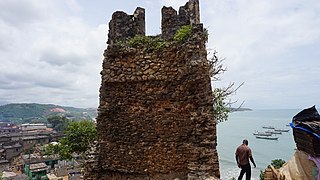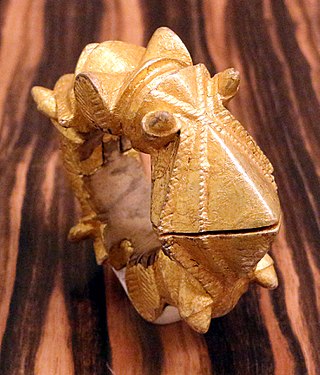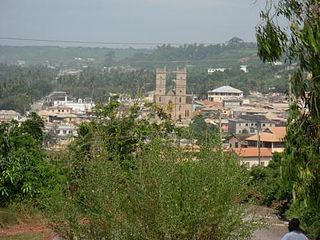
Axim is a coastal town and the capital of Nzema East Municipal district, a district in Western Region of South Ghana. Axim lies 64 kilometers west of the port city of Sekondi-Takoradi in the Western Region, west of Cape Three Points. Axim has a 2013 settlement population of 27,719 people.
The Fante Confederacy refers either to the alliance of the Fante states in existence at least since the sixteenth century, or it can also refer to the modern Confederation formed in 1868. The Confederation is seen as one of the first and most prominent self-rule movements in Ghana and the entirety of Africa. Its mission was to shake off colonialism and establish a modern free democratic state.

The Central Region is one of the sixteen administrative regions of Ghana. It is bordered by Ashanti and Eastern regions to the north, Western region to the west, Greater Accra region to the east, and to the south by the Gulf of Guinea. The Central Region is renowned for its many elite high schools and an economy based on an abundance of industrial minerals and tourism. The Central region boasts of many tourist attractions such as castles, forts and beaches dotted along the region's coastline.

Abura/Asebu/Kwamankese District is one of the twenty-two districts in Central Region, Ghana. Originally created as an ordinary district assembly in 1988, which was created from the former Mfantsiman District Council. The district assembly is located in the southwest part of Central Region and has Essakyir as its capital town.

The Dutch Gold Coast or Dutch Guinea, officially Dutch possessions on the Coast of Guinea was a portion of contemporary Ghana that was gradually colonized by the Dutch, beginning in 1612. The Dutch began trading in the area around 1598, joining the Portuguese which had a trading post there since the late 1400s. Eventually, the Dutch Gold Coast became the most important Dutch colony in West Africa after Fort Elmina was captured from the Portuguese in 1637, but fell into disarray after the abolition of the slave trade in the early 19th century. On 6 April 1872, the Dutch Gold Coast was, in accordance with the Anglo-Dutch Treaties of 1870–71, ceded to the United Kingdom.

The Brandenburger Gold Coast, later Prussian Gold Coast, was a part of the Gold Coast. The Brandenburg colony existed from 1682 to 1721, when King Frederick William I of Prussia sold it for 7,200 ducats and 12 Black slaves to the Dutch West India Company.

The Treaty of Butre between the Netherlands and Ahanta was signed at Butre, Dutch Gold Coast on 27 August 1656. The treaty regulated the jurisdiction of the Netherlands and the Dutch West India Company over the town of Butre and the surrounding country of Upper Ahanta, creating a Dutch protectorate over the area, and permitting the establishment of Fort Batenstein. The treaty lasted until the Dutch departure from the Gold Coast in April 1872.

Fort Patience is a Dutch-built fort located in the township of Apam, in the Central Region of Ghana. Originally built in 1697, it served as a defensive fortification and a trading post. Because of its testimony to European pre-colonial and colonial influence in West Africa, the fort was inscribed on the UNESCO World Heritage List along with several other forts and castles in Ghana.

The Ahanta/Ayinda are Akan People who live to the north and east of the Nzema. The Ahanta land has been historically known as one of the richest areas on the coast of what is now Ghana.
Asebu was a former Fante chiefdom and town in the Abura/Asebu/Kwamankese District, Central Region, Ghana. In the history of the Gold Coast, Asebu is notable for being the first Fante chiefdom to sign a treaty with the Dutch Republic in 1612. The treaty allowed the Dutch to establish Fort Nassau at Mouri, now known as Moree.

Mfantsiman Municipal Assembly is one of the twenty-two districts in Central Region, Ghana. Originally created as an ordinary district assembly in 1988 when it was known as Mfantsiman District, which was created from the former Mfantsiman District Council; until it was later elevated to municipal district assembly status on 29 February 2008 to become Mfantsiman Municipal District. However, on 28 June 2012, the eastern part of the district was split off to create Ekumfi District; thus, the remaining part has been retained as the Mfantsiman Municipal Assembly. The municipality is located in the southwest part of Central Region and has Saltpond as its capital town.

Fort Nassau, near Moree, Ghana, was the first fort that the Dutch established on what would become the Dutch Gold Coast. Because of its importance during the early European colonial period in West Africa and its testimony to the African gold trade and the Atlantic slave trade, the fort was inscribed on the UNESCO World Heritage list in 1979.

Cape Coast Metropolitan Assembly is one of the twenty-two districts in Central Region, Ghana. Originally created as an municipal district assembly in 1988 when it was known as Cape Coast Municipal District, which was created from the Cape Coast Municipal Council; until it was later elevated to metropolitan district assembly status on 29 February 2008 to become Cape Coast Metropolitan District. The municipality is located in the southwest part of Central Region and has Cape Coast as its capital town; which is also the regional capital of the Central Region.
Busua is a beach resort and fishing village in the Ahanta West District of the Western Region in Ghana, about 30 kilometers west of the regional capital, Sekondi-Takoradi in the Gulf of Guinea. Busua is classified in the category of towns with more than 5,000 inhabitants, with a paved road from Sekondi to reach the town. The inhabitants speak the Akan language dialect Ahanta. Busua fishing village is known for blue marlin and tuna fishery.

The Komenda Wars were a series of wars from 1694 until 1700 largely between the Dutch West India Company and the English Royal African Company in the Eguafo Kingdom in the present day state of Ghana, over trade rights. The Dutch were trying to keep the English out of the region to maintain a trade monopoly, while the English were attempting to re-establish a fort in the city of Komenda. The fighting included forces of the Dutch West India Company, the Royal African Company, the Eguafo Kingdom, a prince of the kingdom attempting to rise to the throne, the forces of a powerful merchant named John Cabess, other Akan tribes and kingdoms like Twifo and Denkyira. There were four separate periods of warfare, including a civil war in the Eguafo Kingdom, and the wars ended with the English placing Takyi Kuma into power in Eguafo. Because of the rapidly shifting alliances between European and African powers, historian John Thornton has found that "there is no finer example of [the] complicated combination of European rivalry merging with African rivalry than the Komenda Wars."

The Ghana Space Science and Technology Institute (GSSTI) was opened officially on 2 May 2012 as Ghana’s first space science, space exploration, astronomy and technology space agency. It is an Institution under the Ghana Atomic Energy Commission. GSSTI and Ghana Space Agency (GhSA) aim to become an arena of excellence in space science, space exploration and space technology through teaching, learning, private spaceflight and space research commercialisation. The centre and space agency will also allow scientists and astronauts to conduct research into astrophysics, remote sensing, natural resource management, weather forecasting, agriculture and national security.

Nana Ama Browne Klutse was born on 23 May 1981 at Nyanfeku Ekroful. She had her primary education at the Anomabo Methodist Primary and JHS.
Amanfi also known as The Giant of Asebu was a Warrior King and the founder of Asebu Kingdom in the Central Region of Ghana.
Gyabankrom is a community in the Abura/Asebu/Kwamankese District in the Central Region of Ghana. Garri is produced and oil palm is processed in Gyabankrom.















